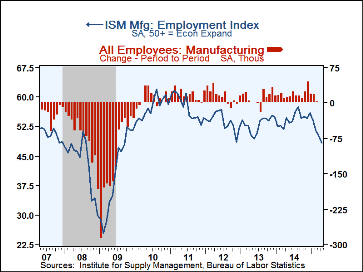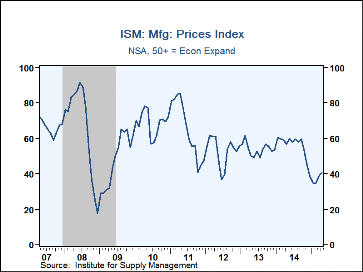 Global| May 01 2015
Global| May 01 2015U.S. ISM Manufacturing Index Remains Weak
by:Tom Moeller
|in:Economy in Brief
Summary
Factory sector activity garnered no momentum last month following sharp deterioration during the winter. The April Composite Index from the Institute for Supply Management (ISM) held steady at 51.5 with the March reading unrevised. [...]
Factory sector activity garnered no momentum last month following sharp deterioration during the winter. The April Composite Index from the Institute for Supply Management (ISM) held steady at 51.5 with the March reading unrevised. The latest figures remained down from the August 2014 high of 58.1, reaching the lowest level since May 2013. Improvement to 52.0 had been expected in the Action Economics Forecast Survey. During the last ten years, there has been a 74% correlation between the level of the index and the q/q change in real GDP.
Showing improvement last month was the production series to 56.0. It remained, however, below its August high of 63.1. Therefore, only modest growth was indicated. New orders rose to 53.5, but here again the index remained well below its August high of 63.9.
The employment reading fell below break-even to 48.3, suggesting negative job growth. It moved to the lowest point since September 2009. During the last ten years, there has been a 65% correlation between the jobs number and the m/m change in factory sector employment. Also declining was the supplier delivery index. The slip to 50.1 followed a plummet during March and indicated the quickest product delivery speeds since May 2013. The decline in the inventories index to 49.5 suggested decumulation for the first time since December.
The prices paid index recovered for the second straight month. At 40.5, it was the highest level since November. The latest level was down, however, from 60.5 in January of last year. Seven percent (NSA) of respondents indicated paying higher prices while 26% paid less.
Export orders improved to 51.5, the highest level since December but still was below the 59.5 level reached in November 2013. The import orders series recovered its March decline with a rise to 54.0 but remained below last year's high of 58.0. Order backlogs held steady at 49.5, down from 57.5 in March of last year.
The figures from the Institute For Supply Management (ISM) are diffusion indexes. A reading above 50 represents growth in factory sector activity. They can be found in Haver's USECON database. The expectations number is in the AS1REPNA database.
Job Switching and Wage Growth from the Federal Reserve Bank of Chicago is available here.
| ISM Mfg | Apr | Mar | Feb | Apr '14 | 2014 | 2013 | 2012 |
|---|---|---|---|---|---|---|---|
| Composite Index | 51.5 | 51.5 | 52.9 | 55.3 | 55.7 | 53.8 | 51.7 |
| New Orders | 53.5 | 51.8 | 52.5 | 56.2 | 59.0 | 56.9 | 52.9 |
| Production | 56.0 | 53.8 | 53.7 | 57.1 | 59.2 | 57.5 | 53.7 |
| Employment | 48.3 | 50.0 | 51.4 | 54.7 | 54.5 | 53.2 | 53.8 |
| Supplier Deliveries | 50.1 | 50.5 | 54.3 | 55.4 | 55.0 | 51.9 | 50.0 |
| Inventories | 49.5 | 51.5 | 52.5 | 53.0 | 50.8 | 49.4 | 48.2 |
| Prices Paid Index (NSA) | 40.5 | 39.0 | 35.0 | 56.5 | 55.6 | 53.8 | 53.2 |
Tom Moeller
AuthorMore in Author Profile »Prior to joining Haver Analytics in 2000, Mr. Moeller worked as the Economist at Chancellor Capital Management from 1985 to 1999. There, he developed comprehensive economic forecasts and interpreted economic data for equity and fixed income portfolio managers. Also at Chancellor, Mr. Moeller worked as an equity analyst and was responsible for researching and rating companies in the economically sensitive automobile and housing industries for investment in Chancellor’s equity portfolio. Prior to joining Chancellor, Mr. Moeller was an Economist at Citibank from 1979 to 1984. He also analyzed pricing behavior in the metals industry for the Council on Wage and Price Stability in Washington, D.C. In 1999, Mr. Moeller received the award for most accurate forecast from the Forecasters' Club of New York. From 1990 to 1992 he was President of the New York Association for Business Economists. Mr. Moeller earned an M.B.A. in Finance from Fordham University, where he graduated in 1987. He holds a Bachelor of Arts in Economics from George Washington University.










